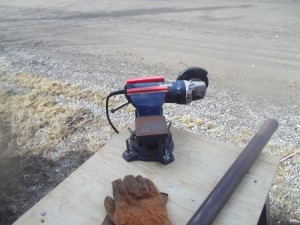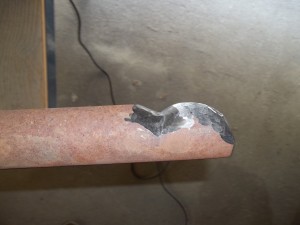While working on a pair of greaves, I decided that there must be a better way of compressing the ankle area instead of hammering into the horn of an anvil. This does work but it’s sloooow…
So I had a chat with a few folks, and they suggested a saddle stake. Unfortunately for me my legs are crazy long, so working around a saddle stake looked to be a bit tricky (Peter Fuller had one in town that I played with briefly) so I decided that I would make a longer version of this stake and mount it in my large vice. The first version of this was made with a 2′ (~60cm) long section of 1.5″ (~40mm) diameter steel bar, and was quite nasty, but still more effective than just the straight bar:

This worked reasonably well, and since I was using mild steel (which planishes nicely) I wasn’t too worried about clean-up, but kept thinking that I should make this into a nicer tool. The major issues I had were that the tool itself was short (I needed to put it into the very end of the vice for some sections of the greave) and since it was fairly light stock, it didn’t have a lot of mass, so I was spending a lot of time (but less than without it) compressing metal in the ankle area of the greave.
And then I got my hands on 9′ (3m) of 2″ (50mm) stock in roughly 3′ (1m) sections and decided that I should make a nice tool without the nasty bumps so that I could flare and compress stainless steel. I started with my grinder in the vice, but quickly switched to put the steel bar in the vice, since it was much easier to move the grinder than the bar. Rough shaping took about 45 minutes, and my hands were pretty tingly afterwards from the vibration – time to take a break!
The rough shaping done, I switched to the auto body polisher and used 180 grit to grind the facets down to a reasonable level. this was fairly involved and probably took another 30 minutes. Fortunately the polisher has a lot more mass, since I’d rather have tired arms than be vibrating the living daylights out of my hands. A respirator is a requirement for the sanding, since the dust is pretty nasty: I tend to use a respirator for the rough grinding as well, but the dust (done outdoors) wasn’t actually all that bad. With the sander you can tell where the respirator, hearing protection and glasses sit, since I look a bit like a reverse raccoon when I take them off – white around the eyes and mouth, much darker everywhere else!
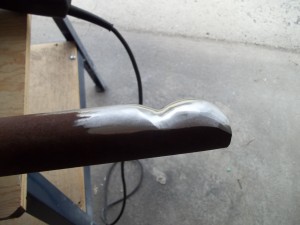
Going to 400 grit prior to polishing took another 20 minutes or so. Generally I’d do 180 / 240 / 320 / 400 but I wore down my 180 grit on the last 10 minutes of work, and it looked like it was leaving scratches similar to ~240 grit, and had an even shape. as usual, if you have any “bumps” or areas where it’s hard to get scratches out, go up the the last grit you used (or even up 2 grits) to even these out, since something that will take 5 minutes with 180 grit will take hours with 320 grit. Fortunately (I’ve probably been doing this too long) the 400 grit cleaned up quite nicely without any irregularities.
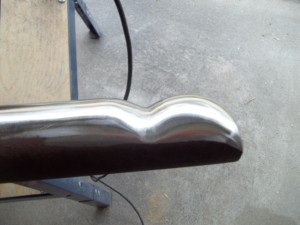 |  |
With the sanding out of the way I switched to the polisher, using white polish. Since the 400 Grit was already reflecting nicely this took about 15 minutes, and by the time I was finished the bar was very hot – you can see where I touched it with the polish and it melted onto the bar with a touch!
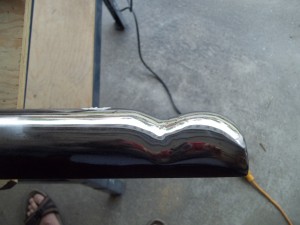 |  |
While not a trivial Job, this didn’t take too much time, and the abrasives used (since it was mild steel bar) weren’t excessive – I generally use more abrasives to clean up a helmet.
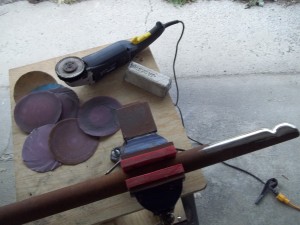
I think that this used 5 180 grit pads and 2-3 400 grit pads, with a moderate amount of white polish. This stake roughly doubled my speed for greave compression, since the smooth shape made compression cleaner and more symmetric. This is probably 10x or more faster than simply trying to flare on an anvil horn, and I now use it for helmets as well since the mass of steel is sufficient to handle this, even when the helmet is only at a dull orange (or in limited areas, with no heat at all)
Scott Martin
